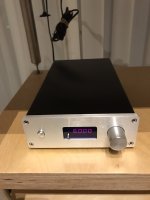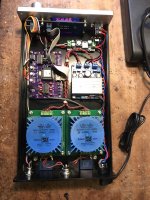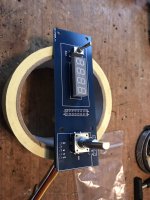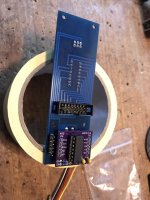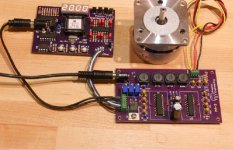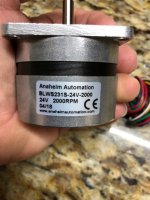true, but I always like to confirm what I think I hear or feel if possible.
I was not referring to your ability to hear or feel, I was referring to your phono cartridge. It is a transducer capable of turning very small physical vibrations into analog electrical signals. I would further suggest that any vibration that it cannot transform into an electrical signal, either by virtue of the vibration's magnitude or its frequency, is irrelevant to the performance of your phono reproduction system.
You also have a preamplifier which can boost the phono cartridge's signal to a more useful level, and any sound card plus something like ARTA is sufficient to digitize that signal and give you a useful comparative measurement, in almost real time.
SG4 is finally assembled and tested. Works really nice, thanks for great design Pyramid!
Two minor issues have:
1) rotary encoder - if I turn it very slow, it works. If do it just normal way any one direction, it increase - decrease frequency and vice versa. Encoder is hi-quality Bourns PEC11R
2) Switching from 60Hz to 81Hz works very good. From 81 back to 60 - transformers start "ticking" and instead of 60Hz there is around 55 (measured with tester. display shows 60"). Pushing on encoder button twice ("standby" and then "on") fix problem. What can be a reason of such behavior?
Two minor issues have:
1) rotary encoder - if I turn it very slow, it works. If do it just normal way any one direction, it increase - decrease frequency and vice versa. Encoder is hi-quality Bourns PEC11R
2) Switching from 60Hz to 81Hz works very good. From 81 back to 60 - transformers start "ticking" and instead of 60Hz there is around 55 (measured with tester. display shows 60"). Pushing on encoder button twice ("standby" and then "on") fix problem. What can be a reason of such behavior?
Attachments
1. Check the 2 caps on the I and Q inputs from the rotary encoder. If they are soldered properly and the correct polarity, try increasing or decreasing the value.
2. If the xfmrs are ticking, the amp is shutting down and resetting. Check that the level is not clipping. You can add small series resistance between the amp output and the xfmr (1-2 Ohms) to prevent this, but it will reduce the output level.
What size motor are you driving?
Nice job on the PCB for the display!
2. If the xfmrs are ticking, the amp is shutting down and resetting. Check that the level is not clipping. You can add small series resistance between the amp output and the xfmr (1-2 Ohms) to prevent this, but it will reduce the output level.
What size motor are you driving?
Nice job on the PCB for the display!
Thank you for assistance Bill.
1. It was wrong polarity. Swapped and now it works as expected.
2. Do you think amp board is not of a good quality? Its cheap Chinese board, less than 10 bucks. I can try a new one.
I will use SG4 (I haven't rewire turntable motor yet) with Sota Moonbeam. Motor is Premotec 9904, which is couple of watts.
1. It was wrong polarity. Swapped and now it works as expected.
2. Do you think amp board is not of a good quality? Its cheap Chinese board, less than 10 bucks. I can try a new one.
I will use SG4 (I haven't rewire turntable motor yet) with Sota Moonbeam. Motor is Premotec 9904, which is couple of watts.
First off thank to Bill, Seth, Ralph and all who contributed to this thread. Over 100 pages now and chocked full of invaluable information.
I'm in the process of ordering parts and it occurred to me that since OshPark requires a minimum order of three boards there maybe some spares floating around that a kind soul may want to part with (given adequate compensation)If you have an extra board and wish to sell it - please PM me and let me know how much you want for it. Shipping will be to the US (Durham, NC).
As an aside, for those of us in pandemic lock-down mode: have you noticed picking up a lot more DIY projects lately? ;-)
Thanks,
-bill
I have some of both PCB’s if anyone is still interested. One main PCB and the speed encoder.
I just noticed the output toroids are rated at 25VA each? That seems to work OK if you use both channels of the TDA7294 to drive one toroid; driving both secondaries in parallel from one output channel of the amp may be too great of load for it. Either use smaller toroids for the output or only drive one secondary (12.5VA) with each channel of the amp. With a low power motor you do not need a 25W xfmr for each winding.
Class D amps are very finicky when it comes to overloads on the outputs. They shut down almost instantly when over-current conditions exist, which can happen on inductive loads when the frequency is suddenly changed.
Class D amps are very finicky when it comes to overloads on the outputs. They shut down almost instantly when over-current conditions exist, which can happen on inductive loads when the frequency is suddenly changed.
You are absolutely right - trafos are 25VA each and secondaries are paralleled. I will re-wire secondaries this days.
There is also another opportunity to use second amp board - install it on top of existing one and drive each secondary from one channel, what do you think?
There is also another opportunity to use second amp board - install it on top of existing one and drive each secondary from one channel, what do you think?
- Home
- Source & Line
- Analogue Source
- DIY 4 Phase Sinewave Generator for Turntable Motor Drive
